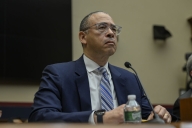You have /5 articles left.
Sign up for a free account or log in.

Getty Images
Starting Tuesday, colleges must tell the U.S. Department of Education if they’re being sued in connection with the federal student loan program.
The requirement promises a wealth of new information about student complaints for department officials who oversee higher ed institutions and could provide earlier warning signs to those officials of financial instability. Although it's not clear if the new disclosures will be made public by the Trump administration, many see added transparency on the financial stability of colleges as a welcome development after a series of abrupt shutdowns by for-profit college chains as well as a number of closures by private nonprofits.
It has also created new headaches for college administrators, who have scrambled in recent weeks to identify litigation they must report.
The disclosure requirements are the latest piece of the Obama-era borrower-defense rule to take effect after Betsy DeVos, the education secretary, lost a legal fight last fall over her attempt to block the regulation. Although DeVos plans to issue her own borrower-defense regulation, her department must carry out provisions of the 2016 Obama rule.
As a result, colleges must now report any pending lawsuits filed by federal or state authorities related to the federal student loan program since July 2017, as well as other pending lawsuits where a court hasn’t granted a summary judgment in the college’s favor.
Colleges also will have to report if their accreditor requests a teach-out plan. And institutions with especially low financial ratings from the department will have to report if an owner withdraws equity.
The requirement to identify what litigation they must report has gotten the most attention from colleges, however. And although the Education Department issued guidance in March on the new requirements, higher ed groups and college lawyers have said they still lack clarity on the new rules.
Do public institutions, for example, have to abide by the same reporting rules? The new standards were designed to produce more up-to-date financial ratings for private nonprofit and for-profit colleges, but the department’s guidance didn’t specify what types of institutions must comply.
And many colleges only recently came to understand what’s required of them under the 2016 rule.
“The biggest challenge is this is all new. The second biggest challenge is the way the reporting requirements on institutions facing lawsuits and litigation are broadly and widely construed,” said Liz Clark, director of federal affairs at the National Association of College and University Business Officers.
Critics of the Obama rule complained that confusion over reporting requirements is the latest indication of how the regulation, which the Trump administration still plans to overhaul, was poorly crafted by the previous administration.
“This is an absolute mess,” said Dennis Cariello, a former department official and lawyer who advises higher ed clients and served on a federal negotiating committee on the issue.
Cariello was a negotiator on the rule-making committee that sought, unsuccessfully, to craft a borrower-defense rule before the Obama administration issued its own regulations. He said the reporting requirements on litigation are overly broad. Colleges face all kinds of frivolous lawsuits, Cariello argued, and many have no bearing on an institution’s financial stability.
The disclosure requirements were included in the 2016 borrower-defense rule to help create a clearer picture of the financial health of colleges. Private and for-profit institutions file audited financial statements annually that the department uses to create a composite financial responsibility score for each college.
But the financial statements used to produce those scores are lagging indicators of a college’s financial health, said Dan Madzelan, assistant vice president for government and public affairs at the American Council on Education.
“The idea was there may be potential liabilities that have not yet been reflected in a financial statement,” Madzelan said. “It’s kind of an early warning system or a heads-up for the department and colleges that they might have a composite score issue.”
Clare McCann, a former Obama administration official and deputy director for federal higher education policy at New America, said more real-time information on financial risks posed to colleges would mean federal officials should have less reason to be surprised by college failures.
“People who are supposed to be responsible for oversight of schools and protecting taxpayers will have a wealth of new information at their disposal,” she said. “If the department has that information, they have far less of an excuse not to use it.”








